Sustainability has come a long way from its roots in compliance and risk management. Now it's meant to drive business strategy and create value. But if you work in sustainability, you'll know the reality isn't always straightforward.
Even as sustainability has moved up the corporate ladder, the day-to-day challenges haven't got much easier. Getting colleagues on board, making sense of ever-changing regulations, proving your worth to the C-suite, these problems persist across every industry.
As part of our Voices of Sustainability initiative, we spoke to sustainability professionals in media, manufacturing, finance, and fashion to understand what's really holding teams back and what actually works to fix it. We'll learn in this article that the solutions go beyond carbon accounting to understanding how businesses really operate and getting people to care.
Gaining organisational recognition and internal buy-in
The challenge of legitimacy
One of sustainability professionals' most fundamental challenges is establishing credibility and securing meaningful support from leadership and colleagues. As Maude Rougier, Sustainability Manager at Deimos Group explains,
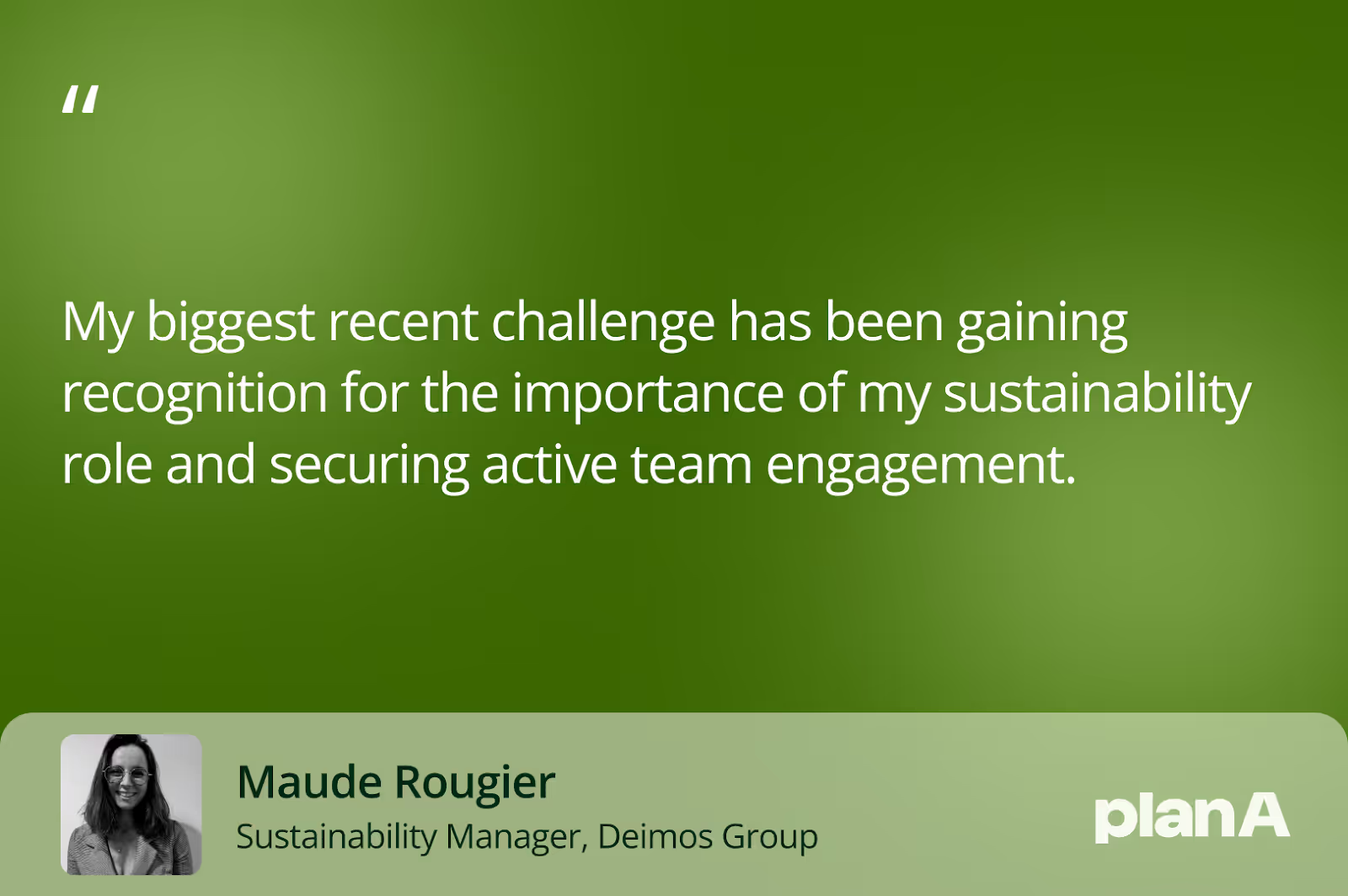
This challenge manifests in several ways. Senior executives may view sustainability as a cost centre rather than a value driver, colleagues across departments may resist changes to established processes, and sustainability teams often struggle to demonstrate tangible business impact in the short term.
Strategic solutions for building recognition
The most effective approach combines visible wins with strategic communication. Rougier successfully addressed this by implementing tangible initiatives alongside foundational work:
I try to balance foundational projects with tangible actions like our water fountain initiative, which not only reduces plastic waste visibly but also creates a sense of personal pride among colleagues when they see the concrete impact.
Creating regular tracking systems proves essential for demonstrating progress. Weekly review processes documenting all sustainability actions, including research and failed attempts, provide concrete evidence of value creation over time. This systematic approach helps sustainability professionals articulate their contributions during performance reviews and budget discussions.
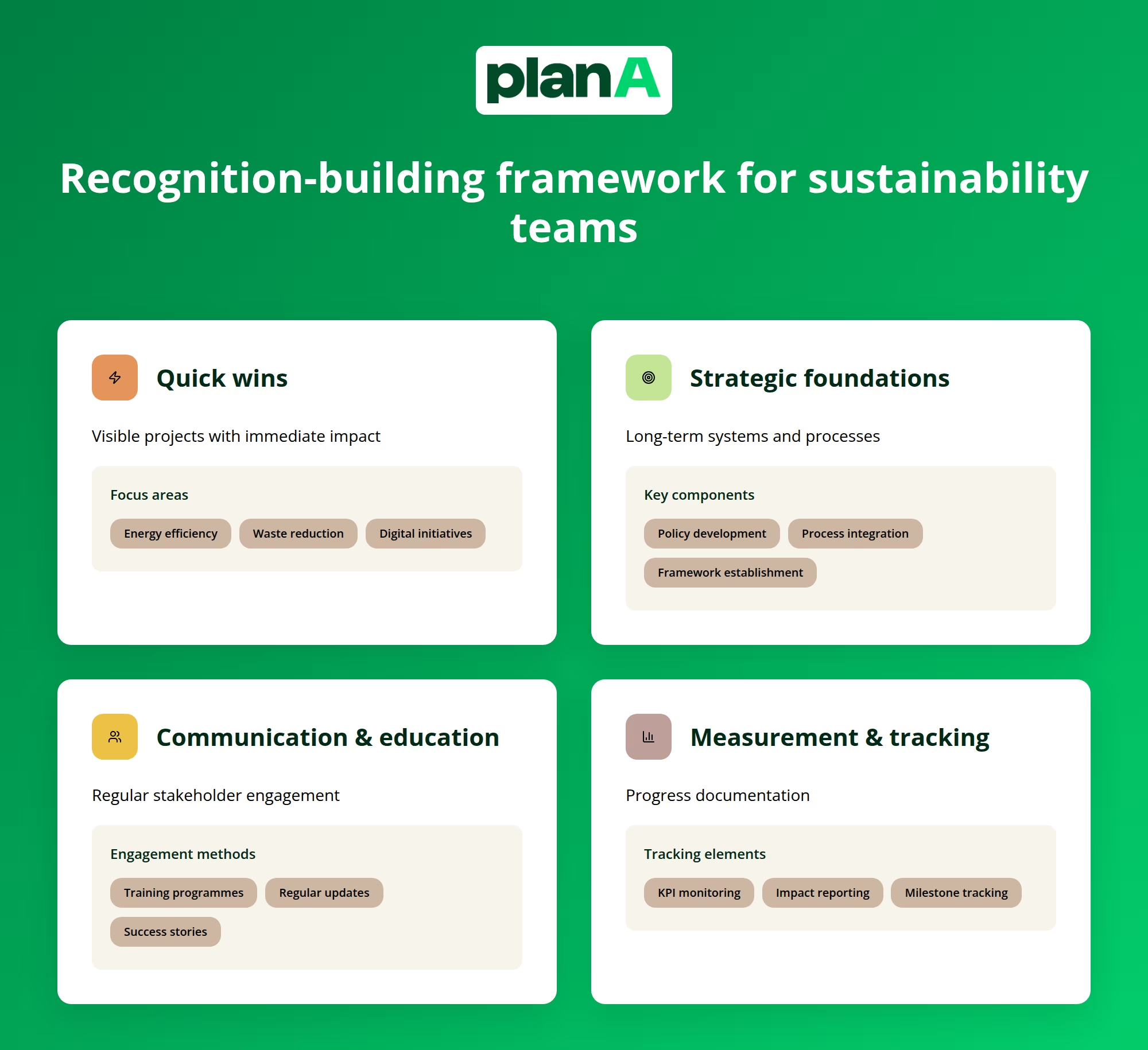
Embedding sustainability across business functions
Rather than operating in isolation, successful sustainability teams position themselves as strategic partners across all business units. As Drishti Masand, Senior Manager, Sustainability Direction at adidas AG, emphasises,
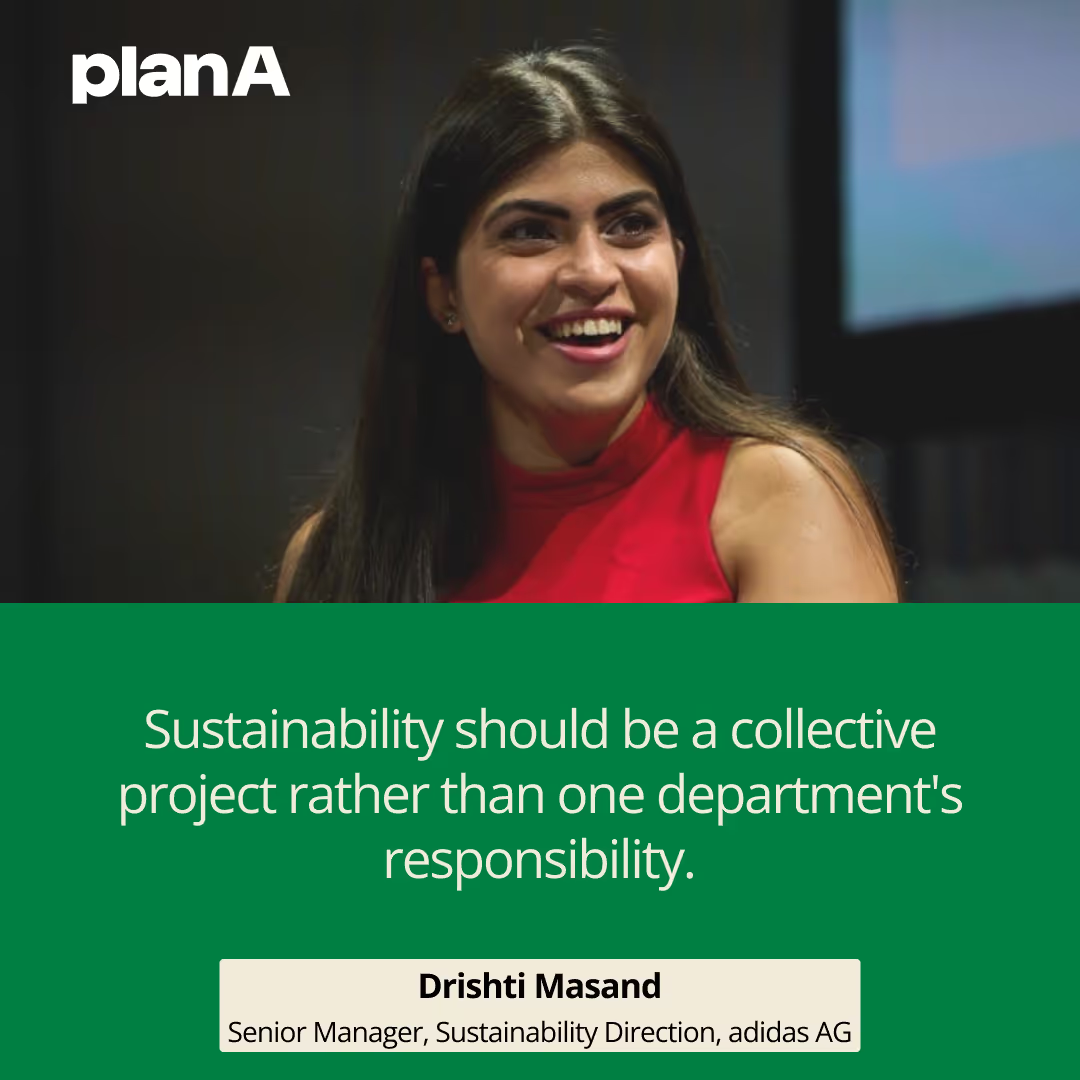
This integration requires sustainability professionals to develop a deep understanding of how different departments operate and identify synergies between sustainability objectives and business goals. Plan A supports this integration by providing comprehensive carbon management solutions that connect sustainability metrics to operational decisions across departments.
Bridging the implementation gap between strategy and operations
The strategy-execution disconnect
Many organisations publicly commit to ambitious sustainability targets but struggle to translate these commitments into operational reality. Gus Bartholomew from Leafr identifies this as a critical challenge:
Many organisations publicly commit to net zero or ESG goals, but the actual delivery often gets trapped in a cycle of strategic intent without tactical enablement.
This gap emerges from several factors: insufficient resource allocation, lack of clear accountability structures, inadequate data collection systems, and failure to integrate sustainability considerations into day-to-day decision-making processes.
Building robust execution frameworks
Successful implementation requires moving beyond high-level commitments to create detailed, actionable roadmaps. Erik Sørensen Sustainability and Global Partnerships Manager at Modulex Group, demonstrates this approach by creating comprehensive evaluation criteria:
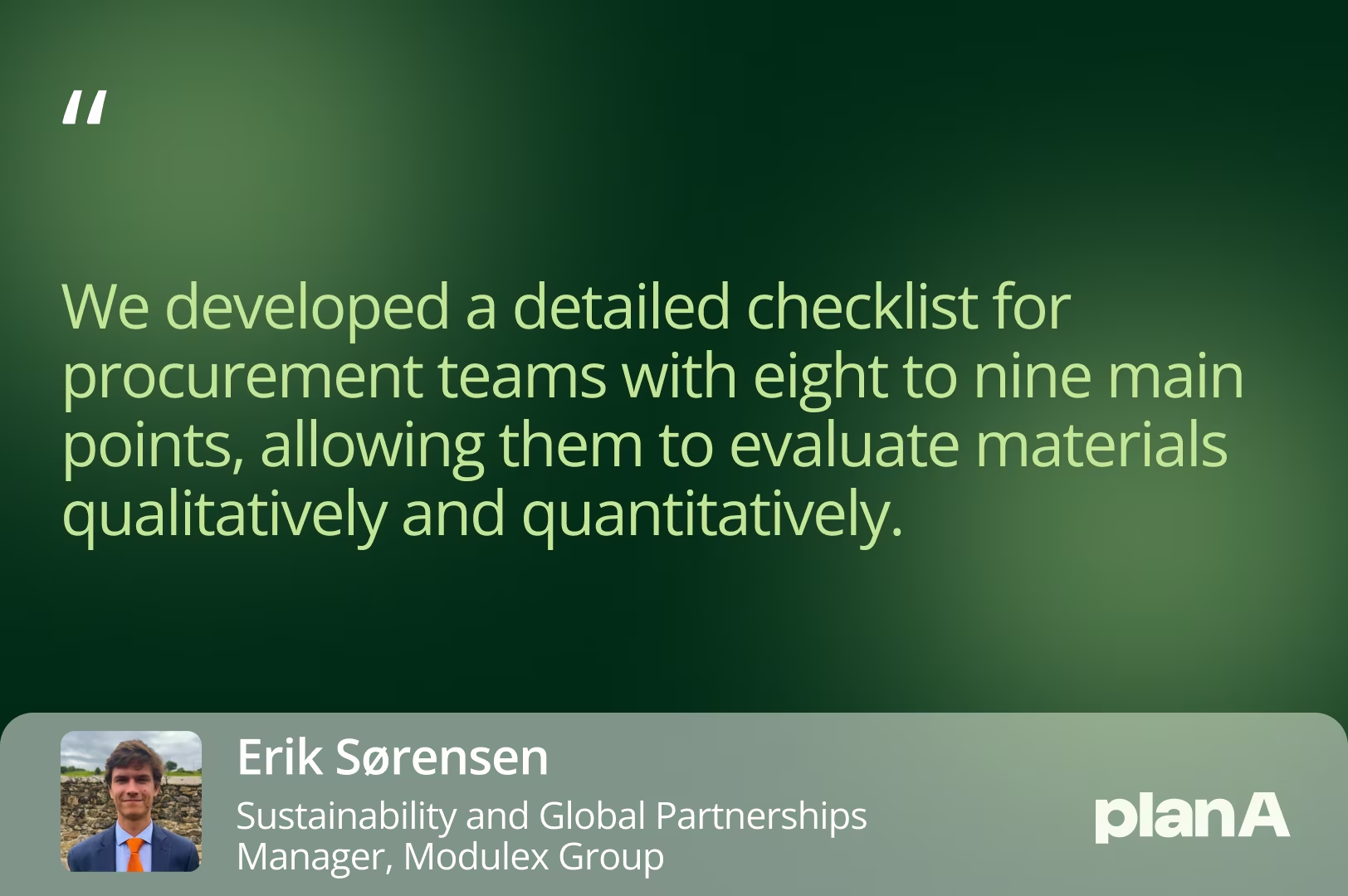
The most effective frameworks include:
- Clear data architecture with defined ownership and automated inputs
- Consistent methodologies that balance rigour with practical application
- Strategic decision mapping that connects emissions hotspots to business levers
- Portfolio approach that prioritises high-impact, feasible actions with clear accountability
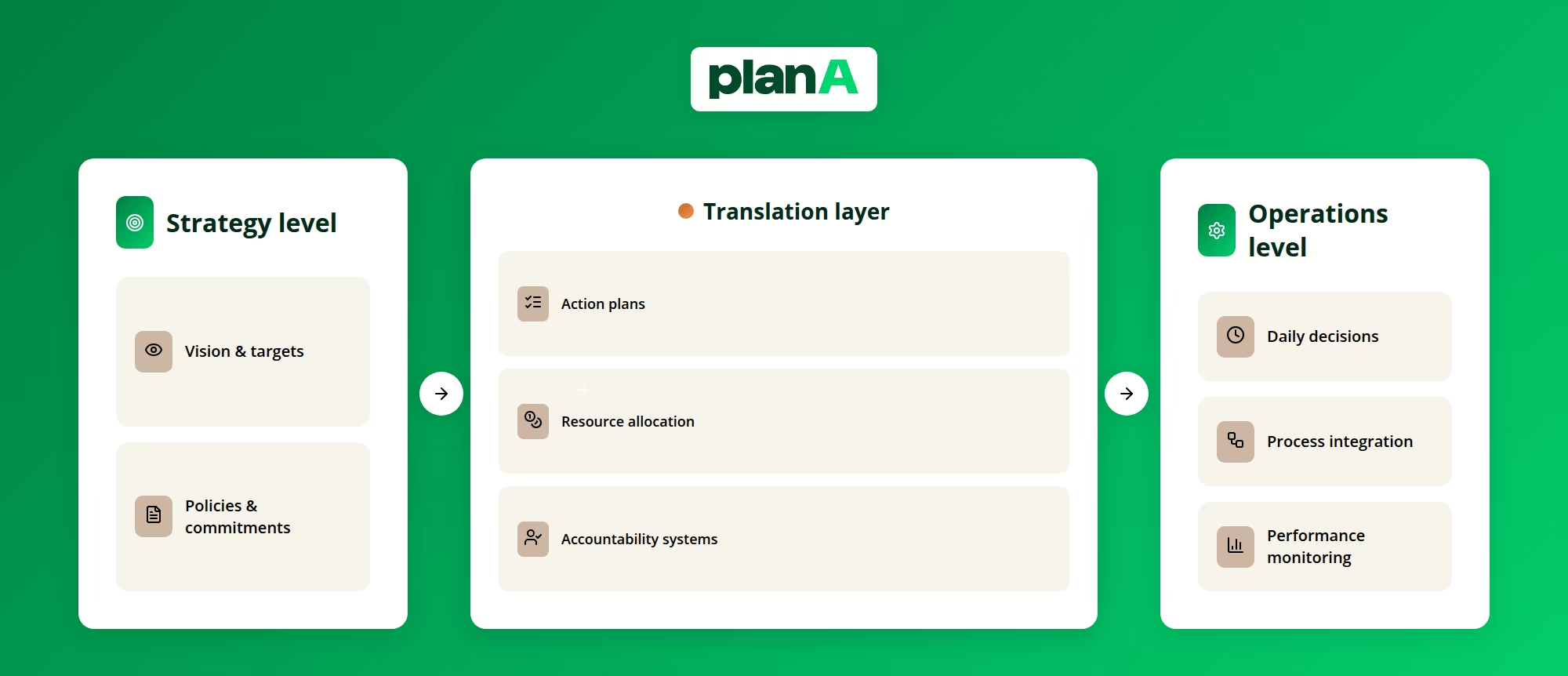
Leveraging technology for operational integration
Technology platforms play a crucial role in bridging the implementation gap. Plan A's carbon management platform enables organisations to collect data efficiently, measure emissions accurately, and track progress against targets in real-time, ensuring that strategic commitments translate into operational outcomes.
Managing regulatory complexity and constant change
The challenge of the evolving compliance landscape
Regulatory requirements in sustainability continue to expand and evolve rapidly, creating significant challenges for teams trying to maintain compliance while driving meaningful impact. Giovanni Migliore, ESG and Sustainability Senior Manager at Flix, captures this difficulty:
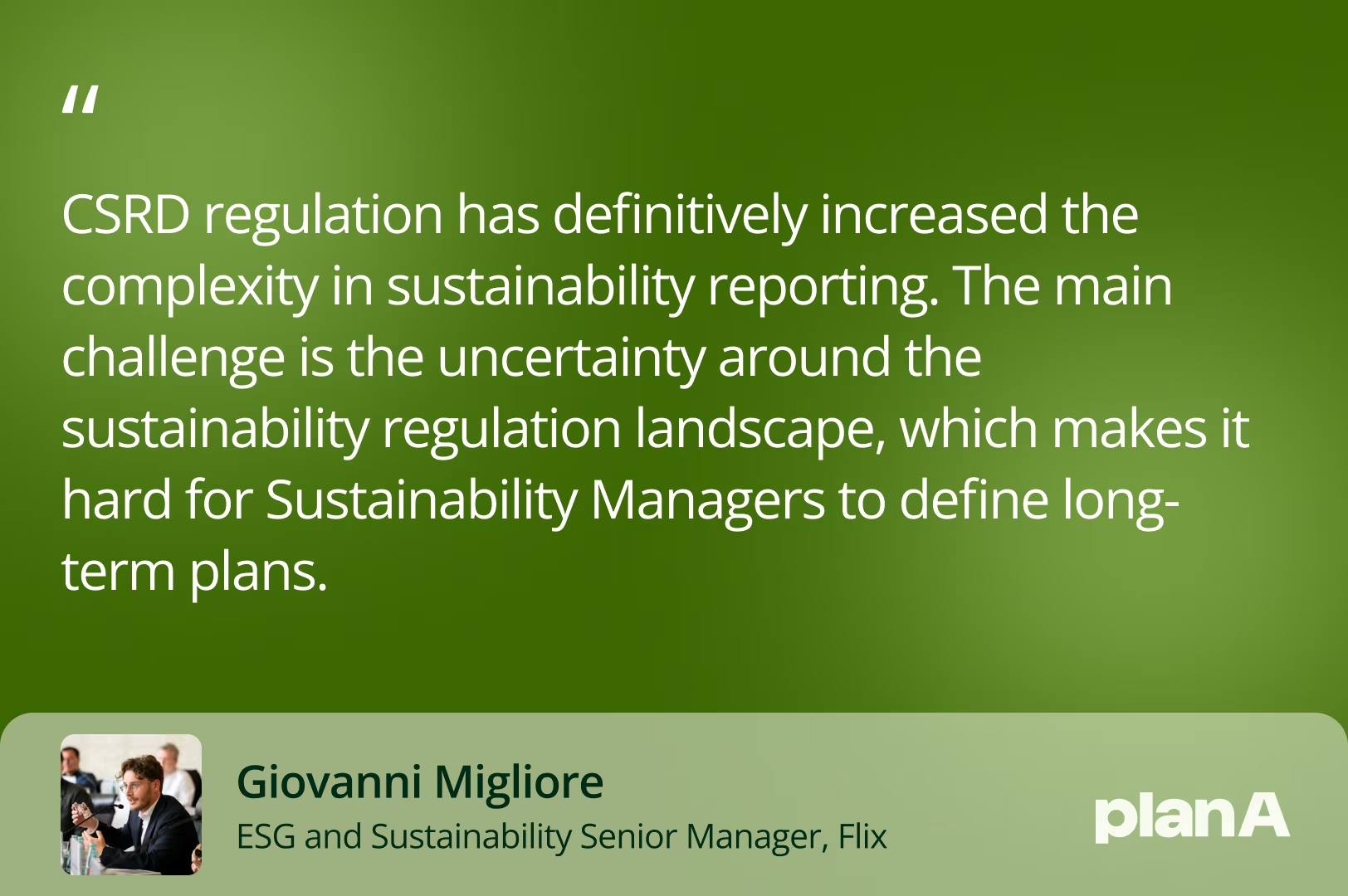
This regulatory complexity manifests through multiple, overlapping frameworks, frequent updates and changes, varying requirements across jurisdictions, and the need to balance compliance with genuine impact creation.
Developing adaptive regulatory strategies
Rather than treating compliance as a box-ticking exercise, successful sustainability teams use regulatory requirements as a framework for strategic development. Maude Rougier explains:
For companies like ours at the beginning of their journey, CSRD compliance has been a powerful lever for structuring our approach and providing a clear reading framework and methodology for foundational work.
Staying ahead of regulatory changes
Proactive regulatory management requires establishing systems for continuous monitoring and adaptation. As Christoph Bock, Senior Expert ESG & organisational development at RTLZWEI, advises:
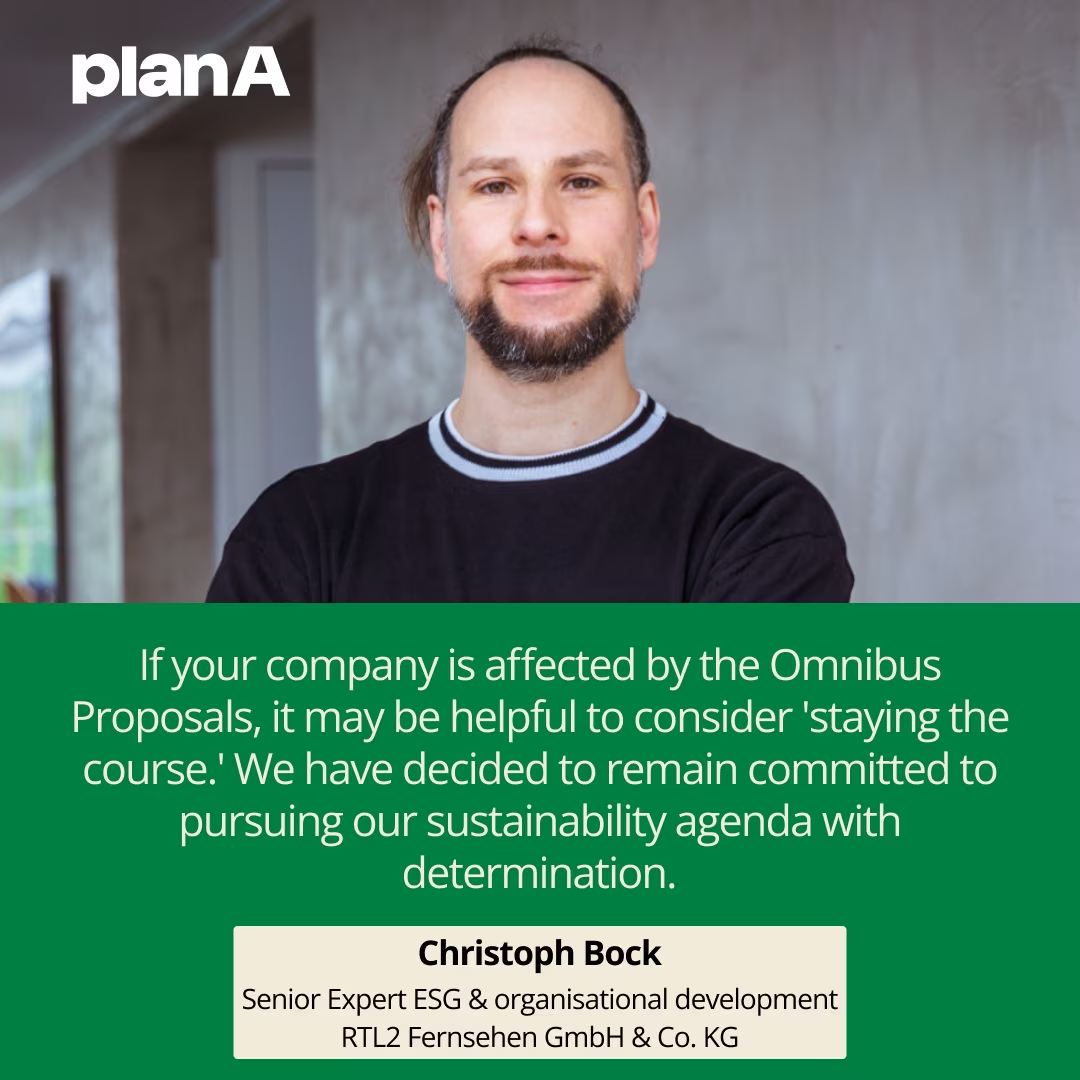
This approach involves completing materiality analyses that provide foundations for strategic development, conducting gap analyses to identify data collection needs, and using freed-up resources for measures with direct impact rather than purely compliance-focused activities.
Plan A's reporting capabilities help organisations navigate regulatory complexity by providing automated report generation that adapts to different frameworks while maintaining consistency in underlying data collection and analysis.
We've learned this adaptability is crucial as organisations move between different reporting requirements. As Nathan Bonnisseau, co-founder and sustainability manager at Plan A, puts it:
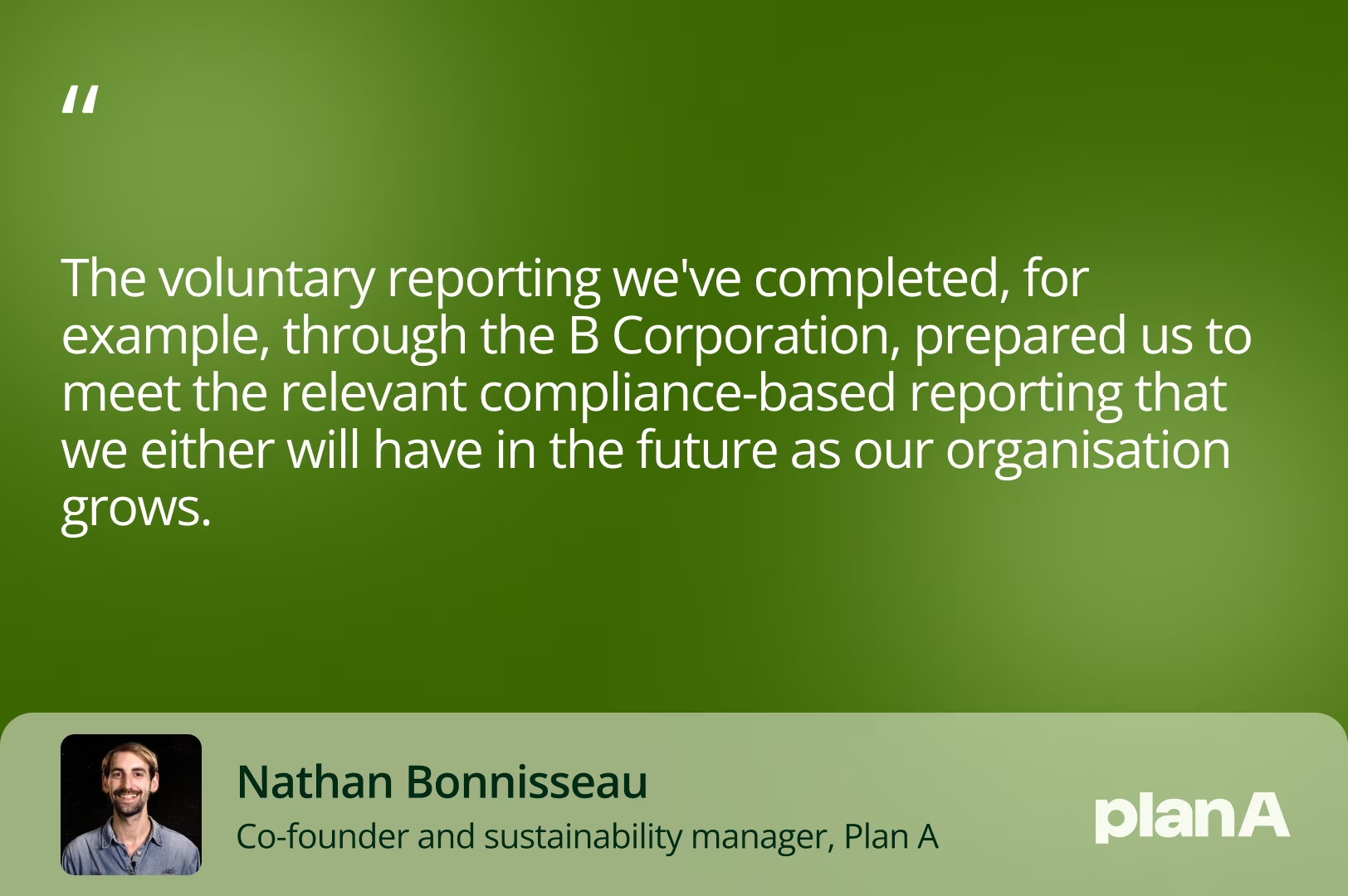
Optimising stakeholder communication and engagement
The communication challenge across diverse audiences
Effective sustainability communication requires tailoring messages for vastly different stakeholder groups, from technical experts to senior executives to frontline employees. Each group requires different levels of detail, focuses on different benefits, and responds to different communication styles.
As Maude Rougier emphasises in her best practices:
Speak differently to financial directors vs. logistics coordinators vs. admin support, identify what matters to each person.
Developing sophisticated communication strategies
Successful sustainability communication combines multiple approaches and formats to maximise engagement across stakeholder groups:
Format diversification proves essential for reaching busy stakeholders. Rather than relying solely on lengthy reports, effective teams use short videos, infographic summaries, interactive dashboards, and targeted presentations to share progress and insights.
Message customisation ensures relevance for different audiences. Financial stakeholders receive cost-benefit analyses and risk assessments, operational teams get process improvements and efficiency gains, while senior leadership sees strategic positioning and competitive advantages.
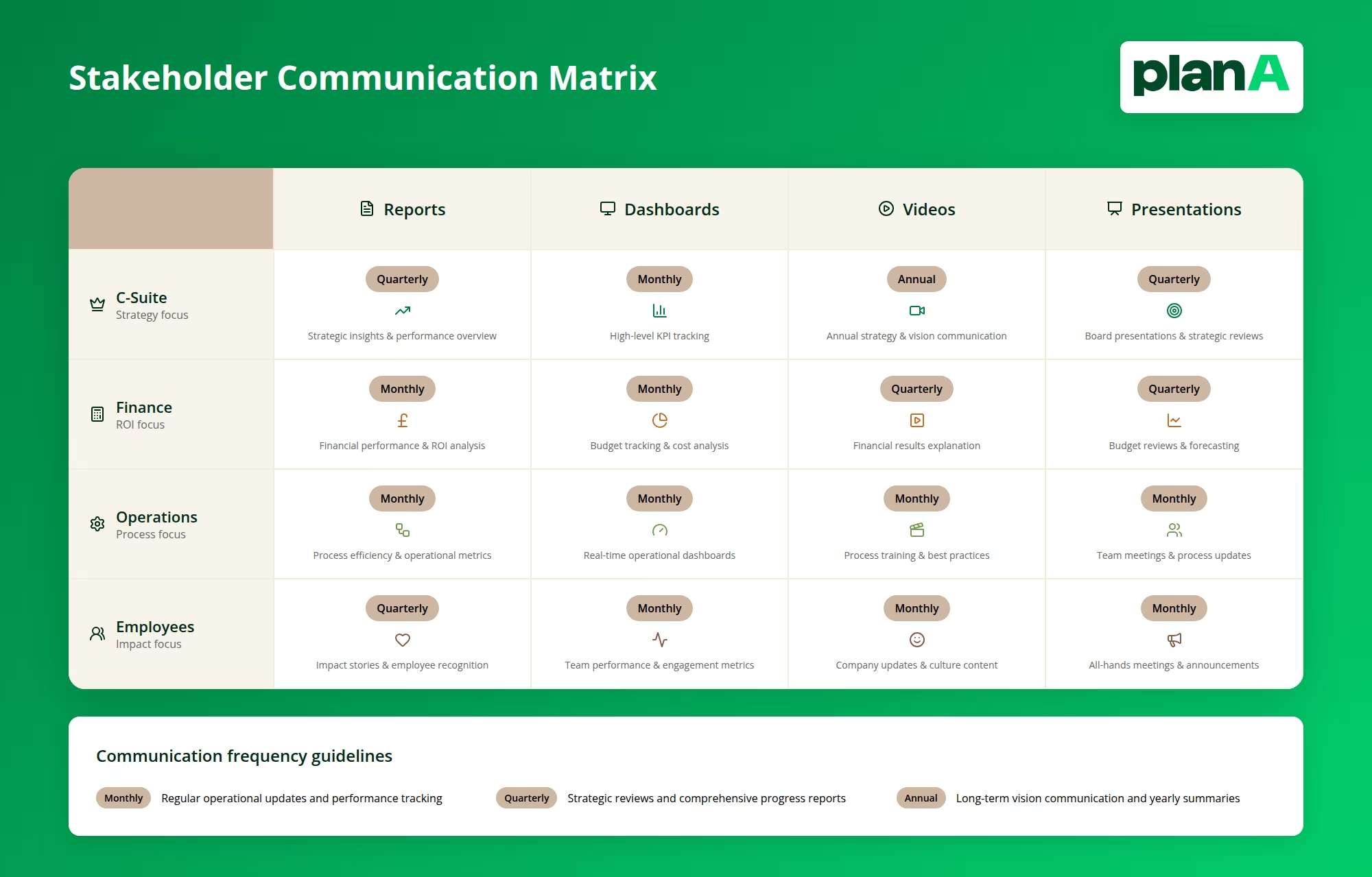
Building internal ambassadors and ownership
The most effective sustainability communication creates multiple champions throughout the organisation rather than relying on a single team. Dany Leroux, Sustainability Manager at L'Oréal Italia explains this approach:
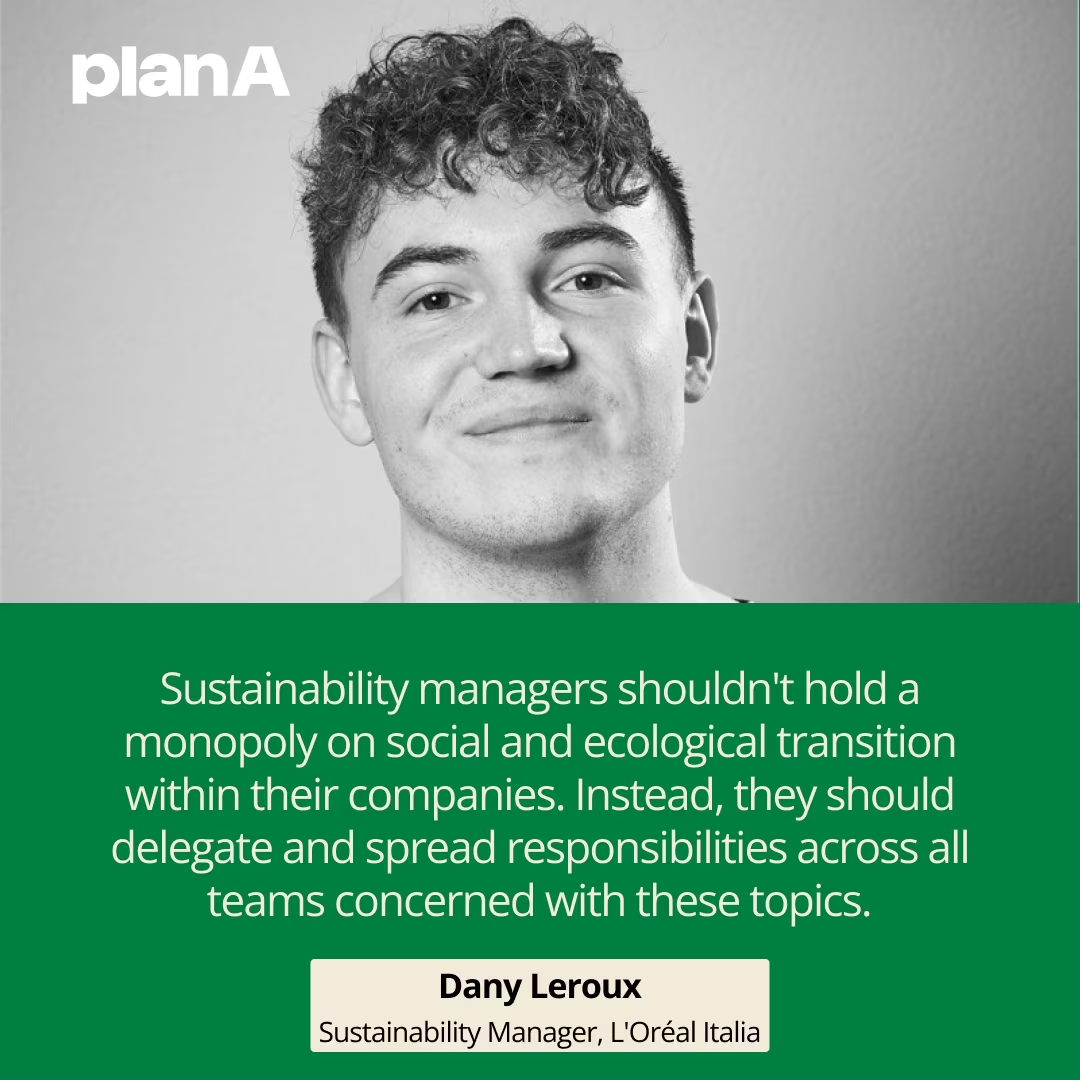
This distributed ownership model requires providing teams with clear objectives and training while allowing them to innovate and take initiative within their areas of expertise. Elena Ricciuti from Holding Industriale’s sustainability team demonstrates this by involving employees as ambassadors:
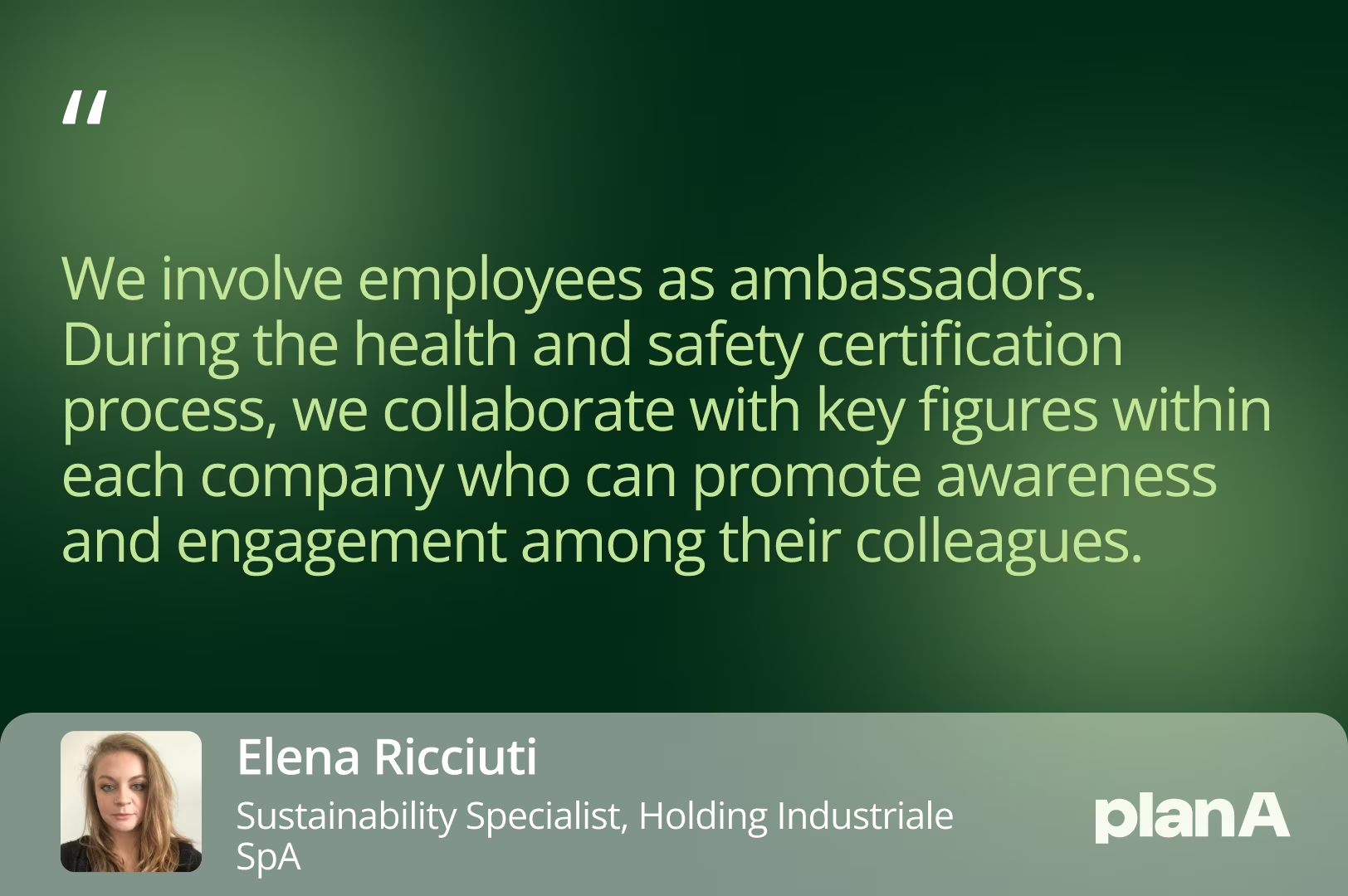
Achieving integration without isolation
Moving beyond siloed sustainability functions
One of the most persistent challenges facing sustainability teams is avoiding the creation of isolated sustainability functions that operate separately from core business operations. This isolation limits impact and prevents sustainability from becoming truly embedded in organisational culture and decision-making.
As Irina Bolgari, Sustainability Manager at La Prairie Switzerland, emphasises:
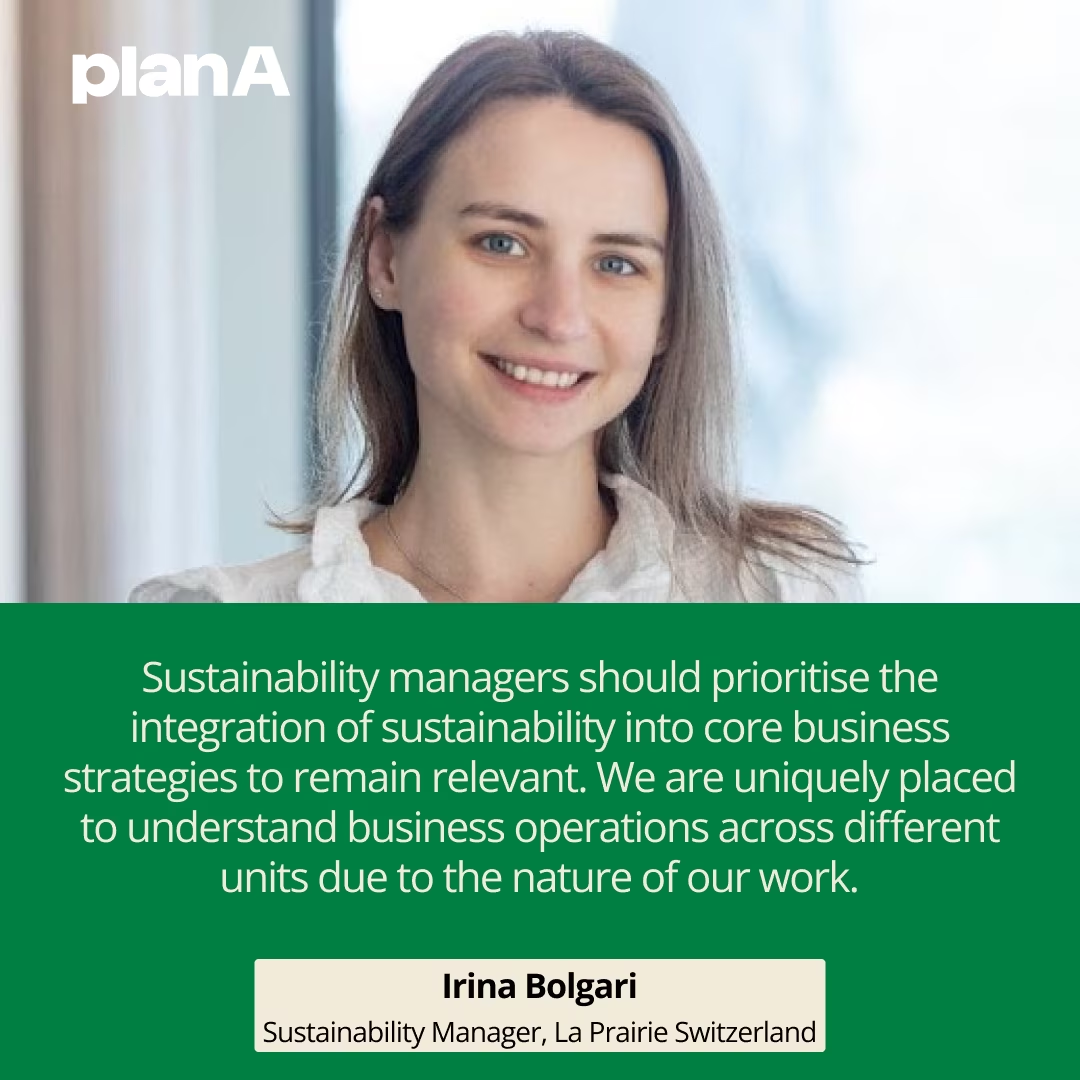
Strategic integration approaches
Successful integration requires sustainability professionals to position themselves as business partners rather than compliance officers. This involves developing deep understanding of how different business functions operate, identifying specific synergies between sustainability goals and business objectives, and creating shared metrics that demonstrate mutual value.
Erik Sørensen from Modulex Group exemplifies this approach:
"Our approach has been to demonstrate that sustainability can be profitable when done correctly. By designing products in a modular way, we provide long-term cost savings for clients."
Creating systematic change rather than project-based initiatives
The most effective sustainability integration focuses on systematic transformation rather than isolated projects. This requires embedding sustainability considerations into existing processes rather than creating parallel sustainability processes.
Key integration strategies include:
- Incorporating sustainability criteria into procurement decisions
- Integrating carbon considerations into financial planning and investment decisions
- Embedding sustainability metrics into performance management systems
- Aligning sustainability objectives with departmental goals and incentives
Leveraging external expertise and networks
The strategic value of external partnerships
Given the complexity and rapid evolution of sustainability requirements, internal teams increasingly need access to specialised expertise that may not be practical to develop in-house. Gus Bartholomew advocates for this approach:
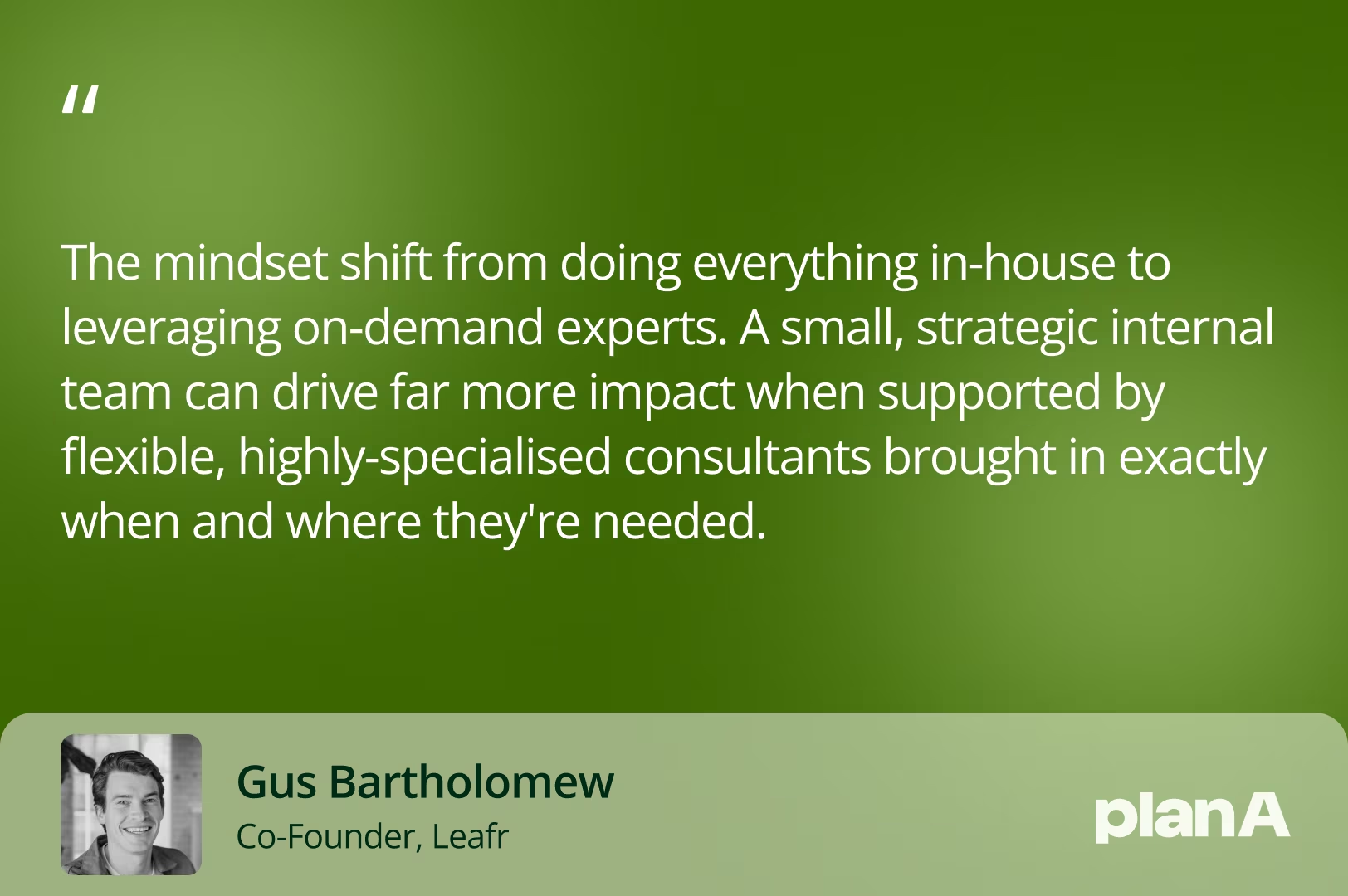
Building effective expert networks
Successful sustainability teams create strategic relationships with external experts while maintaining internal control over direction and priorities. This hybrid approach allows organisations to access cutting-edge expertise while building internal capability over time.
When organisations need comprehensive carbon management support, partnering with specialist platforms like Plan A provides access to scientific expertise, proven methodologies, and automated systems while allowing internal teams to focus on strategic implementation and stakeholder engagement.
Plan A's expert services complement internal teams by providing specialised knowledge in areas like target setting, decarbonisation planning, and regulatory compliance, enabling sustainability professionals to focus on integration and organisational change management.
Measuring progress and maintaining momentum
Creating accountability through tracking systems
One of the most effective ways to overcome sustainability challenges is establishing robust systems for measuring progress and maintaining momentum over time. As Maude Rougier explains:
Every week, I review what I've accomplished and what I need to do the following week. I also keep track of all actions taken, research included, even those that didn't succeed.
This systematic approach serves multiple purposes: demonstrating value to stakeholders, identifying successful strategies for replication, maintaining personal motivation during challenging periods, and providing evidence for resource allocation discussions.
Balancing perfection with progress
Sustainability teams often face the challenge of waiting for perfect data or complete solutions while urgency demands immediate action. Drishti Masand from adidas AG advocates for a balanced approach:
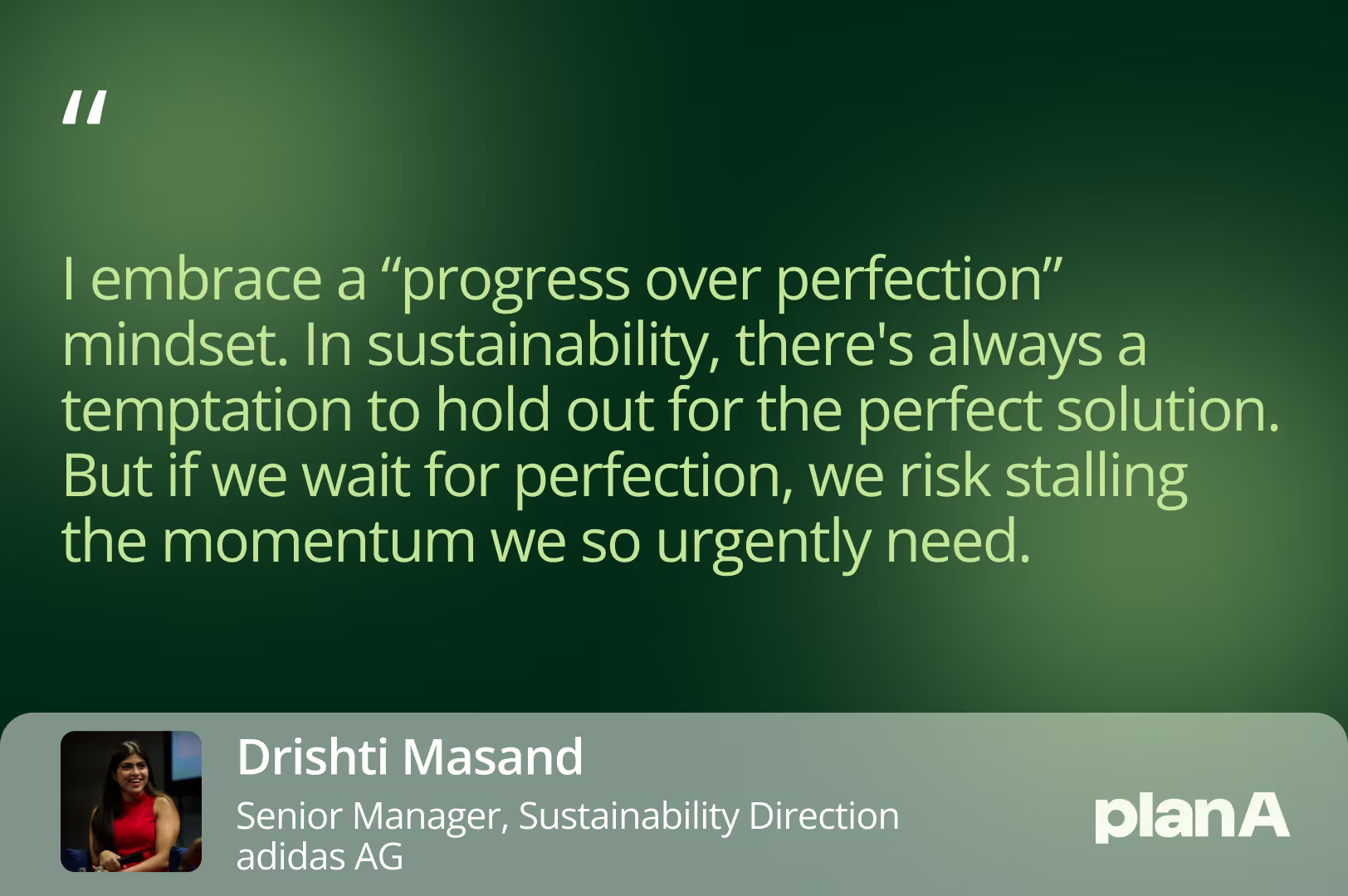
This philosophy enables teams to begin implementation with available data while systematically improving accuracy and completeness over time. It also helps maintain stakeholder engagement by demonstrating consistent progress rather than waiting for breakthrough moments.
Looking forward: building resilient sustainability teams
The challenges facing sustainability teams continue to evolve, but the fundamental success factors remain consistent: strategic positioning, effective communication, systematic implementation, and continuous adaptation. The most successful sustainability professionals combine technical expertise with business acumen, regulatory knowledge with strategic thinking, and individual competence with collaborative leadership.
As Beth Knight, Head of Social Sustainability at Lloyds Banking Group, observes, hope comes from "the support offered by learned and tenured sustainability professionals in peer networks." The sustainability profession has matured significantly, creating communities of practice that share knowledge, support professional development, and accelerate collective impact.
For organisations looking to overcome these challenges, the path forward involves investing in both internal capability development and strategic external partnerships. Plan A's comprehensive platform enables sustainability teams to address multiple challenges simultaneously, from data collection and emissions measurement to strategic target setting and progress tracking, while building internal expertise and stakeholder engagement.
The future belongs to sustainability teams that successfully integrate technical competence with strategic business thinking, regulatory compliance with genuine impact creation, and internal expertise with external partnerships. By addressing these core challenges systematically, sustainability professionals can transform their organisations while advancing the broader transition to a sustainable economy.




.jpg)


.webp)

